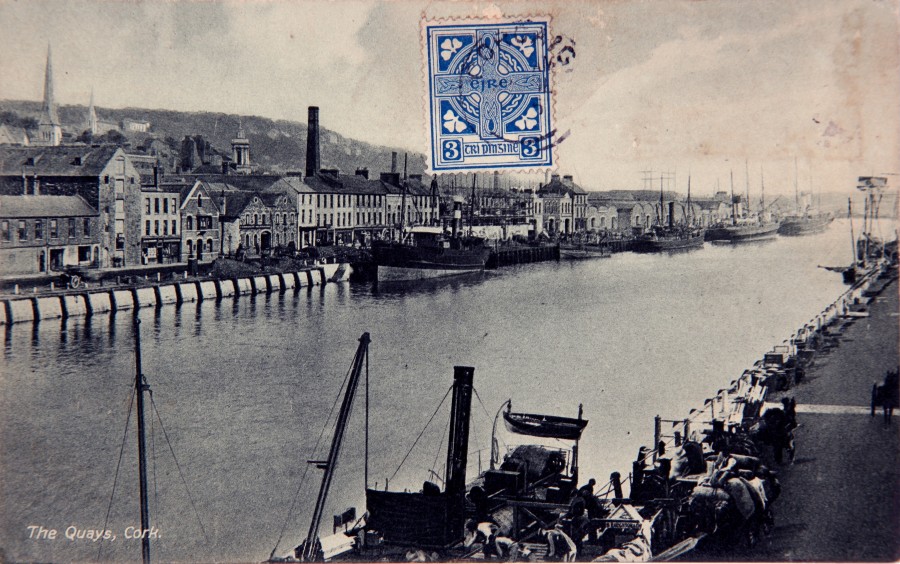
Kieran’s Our City, Our Town Article,
Cork Independent, 30 August 2018
Kieran’s New Book Cork in 50 Buildings
My new book Cork in 50 Buildings (2018, Amberley Publishing) explores the history of this venerable old city through a selection of its greatest architectural treasures, from the St Anne’s Church, Shandon, regarded as a symbol of the city, to more recent additions such as the tower of the County Hall, once the tallest building in Ireland. This book offers a glimpse to explore behind fifty of Cork’s historic buildings.
The city of Cork is a place of tradition, continuity, change and legacy. It is a place of direction and experiment by people of ambition and determination, experiences and learning, of ingenuity and innovation, and of nostalgia and memory. Its extraordinary history is embodied in the buildings that have shaped Ireland’s southern capital.
The biggest challenge for me was to pick a mixture of buildings that should be in this book but also ones, which I do not often get to write about or show on my historical walking tours. Whether or which, this book builds on my previous publications, takes strands of articles from this ongoing local history column, Our City, Our Town. It is also inspired by the annual Cork Heritage Open Day, which is organised by Cork City Council and where over 40 buildings open their doors to the public for one day at the start of National Heritage Week.
This book highlights just some of my favourite buildings and stories that have charmed me. It presents a contextual history of buildings and comments on the buildings’ economic expressions, use of narratives, symbols and metaphors and the social environment. There is a great need to highlight the need for more research on the city’s historic structures, a mapping out of them and to continue to identify new ways of celebrating, managing and championing our built heritage.
Eminent Cork Writer Daniel Corkery’s account of Cork in The Threshold of Quiet (1917) has always resonated strongly with me.
“Leaving us, the summer visitor says in his good-humoured way that Cork is quite a busy place…as hundrum a collection of odds and ends as ever went by the name of city – are flung higgledy piggledy together into a narrow double-streamed, many bridged river valley, jostled and jostling, so compacted that the mass throws throws up a froth and flurry that confuses the stray visitor…for him this is Cork”.
The words “higgledy piggledy” for me best describes the urban fabric of Cork. The mixed “collection of odds and ends” reflects the manner of the city’s evolution. It was built in a piecemeal way by a combination of native and outside influences, its ever-changing townscape and society shaped by different cultures since its origin as a monastic settlement. Cork possesses a unique character, derived from a combination of its plan, topography, built fabric and location.
It is unique among other Irish cities in that it alone has experienced all phases of Irish urban development, from c.AD600 to the present day. The settlement at Cork began as a monastic centre in the seventh century, founded by St FinBarre. It served as a Viking trading post before the Anglo-Normans arrived and created a prosperous walled town. It grew through the influx of English colonists during the sixteenth and seventeenth centuries and suffered the political problems inherent in Irish society at that time. It was altered significantly through Georgian and Victorian times when reclamation of its marshes became a priority, as well as the construction of spacious streets and grand town houses; its quays, docks and warehouses exhibit the impact of the industrial revolution; and in the last one hundred years, Corkonians have witnessed both the growth of extensive suburbs and the rejuvenation of the inner city. Built on the surrounding valleysides of the River Lee, the city’s suburbs are the result of a spiralling population in the twentieth century.
Perhaps, the most important influence on the city’s development was and is the River Lee, which has witnessed the city’s growth from a monastic centre to a cosmopolitan twenty-first-century city. Originally, Cork comprised a series of marshy islands, which the Irish for the city, Corcaigh, or marshes, reflects. Just west of the city centre the Lee splits into two channels, each flowing around the city before meeting again in Cork harbour. This means the city centre is an island, bounded by a north channel and a south channel. The urban centre was built on the lowest crossing-point of the river, where it meets the sea. This situation has given the city a rich maritime history and a strong identification as a port town complete with old warehouses.
With the past of a port city, Cork’s architecture has a personality that is varied and much is hidden amongst the city’s narrow streets and laneways. Much of its architecture is inspired by international styles – the British style of artwork and nineteenth century brick pervading in most cases– but it always pays to look up in Cork and marvel at the Amsterdamesque-style of our eighteenth-century structures on streets such as Oliver Plunkett Street or at the gorgeous tall spires of the city’s nineteenth-century churches. Cork’s most fascinating buildings ranging from the medieval to the military, the civic to the commercial and the educational to the ecclesiastical.
Cork in 50 Buildings by Kieran McCarthy is available online to purchase https://www.amberley-books.com or in any good Cork bookshop. Support local bookshops.
Captions:
961a. Front cover of Cork in 50 Buildings by Kieran McCarthy
961b. Re-enactment at Elizabeth Fort for the recent Cork Heritage Open Day, one of the sites in Kieran’s new book Cork in 50 Buildings (picture: Kieran McCarthy)
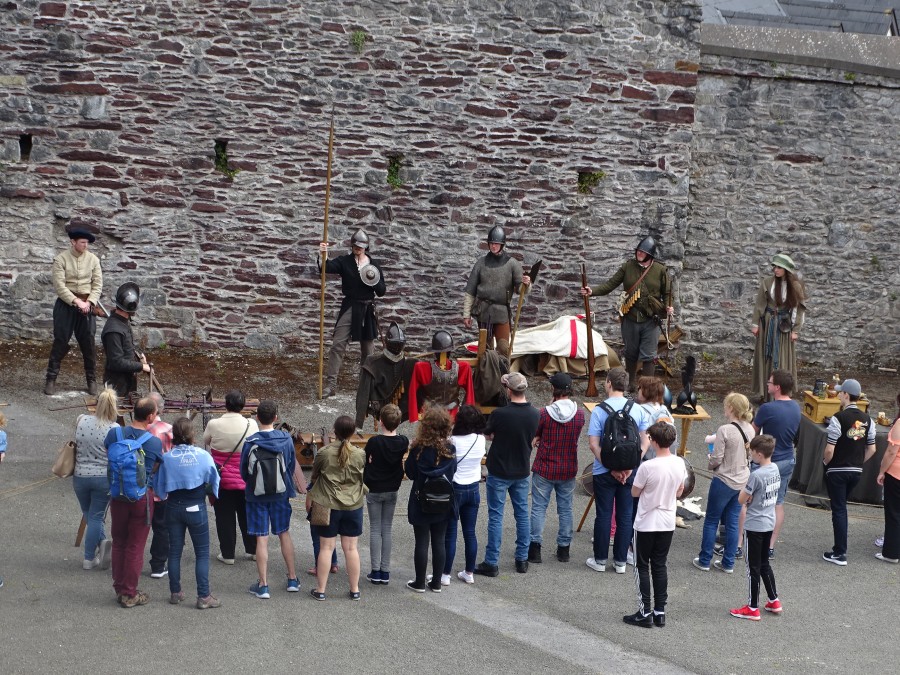
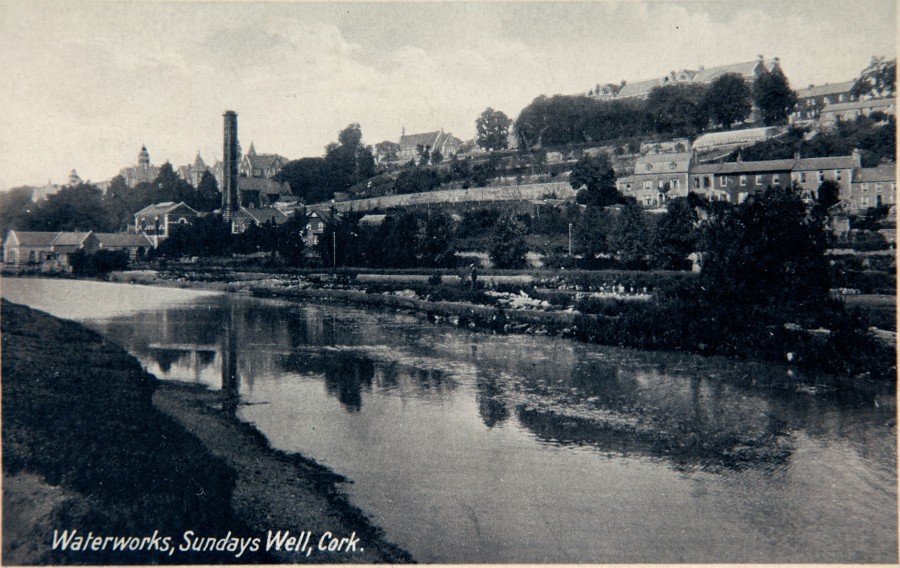
Kieran’s Our City, Our Town Article,
Cork Independent, 23 August 2018
Water Heritage Open Day, 26 August 2018
National Heritage Week continues at pace this week. The Old Cork Waterworks Experience presents “Water Heritage Open Day” on Sunday 26 August, 11am-4pm. It is a family fun day themed on the industrial heritage and history of Cork’s Victorian Waterworks on Lee Road. Throughout the day the team there will provide guided tours of the impressive engine and boiler rooms, offer an insight into the working day of a waterworks employee and map the role of water supply with the growth of Cork City. There will also be a range of engaging and educational activities available including a puppet show, marine science, giant bubbles as well as launching water rockets and a water science zone.
Officially opened in October 2005, the formerly named Lifetime Lab was a Cork City Council initiative funded by EFTA or the European Free Trade Association, and was a welcome move in protecting and reinvigorating Cork’s heritage stock. The old waterworks on Lee Road, was converted into a “lab” where visitors of all ages, especially children could enjoy a modern interactive exhibition, steam plant, beautifully restored buildings, children’s playground and marvellous views over our Lee Fields.
The buildings, which stand at the old Waterworks site today, date from the 1800s and 1900s but water has been supplied to the city of Cork from the site since the 1760s. A foundation stone today commemorates the building of the first pump-house, which was itself constructed on the Lee Road in the late eighteenth century. It was in 1768, that a Nicholas Fitton was elected to carry out the construction work needed for a new water supply plan. The water wheel and pump sent the river water unfiltered to an open reservoir called the City Basin, which was located on an elevated level above the Lee Road. This water was then pumped from here to the city centre through wooden pipes.
Between the years 1856 and 1857, the Corporation of Cork obtained a sanction from the parliamentary treasury to acquire a loan of £20,000 to upgrade the Lee Road waterworks. In February 1857, John Benson’s plan for a new waterworks was given to several eminent engineers in London for consultation. Much of it was based on Londoner Thomas Wickstead’s 1841 survey and plan for the provision of water to the Cork public in association with the Corporation of Cork. By May 1857, tenders were issued and cast-iron mains were chosen to replace the wooden pipes. They were initially shipped to Cork in 1857 and during the ensuing two years, the pipes were laid down. By February 1859, the pipes from the new waterworks to the military barracks on the old Youghal Road were in place. It was here that a new reservoir was to be constructed. The reservoir itself was to cover one acre and was five metres deep with a capacity of four million gallons.
In 2004-05, the conservation and restoration of the Old Waterworks site was all under the watchful eye of Jack Coughlan and Associates, industrial archaeologist Dr Colin Rynne and Imagination Ltd. Of all the buildings on the site, the steam engine building required the least amount of restoration work. Some water that had seeped through the roof had caused some deterioration of timber work, but in general, the building remained as it was built, one hundred years previously. The roofs were re-slated, with the maximum amount of slate salvaged and re-used. All steel and timber trusses were retained. Two modern interventions were made to this building. Firstly, a viewing gallery was inserted to allow visitors a fully accessible birds’ eye view of the steam engines without the necessity to enter the engine room via the exterior stone steps. Secondly, large glass doors were inserted to the two arches to the boiler house. These openings were originally without doors as the coal to feed the boilers was piled outside the buildings and shovelled by the stokers. The engines and boilers still remain in the buildings today.
The chimney stack, 44 metres in height from the base to the capping, was designed to disperse the exhaust fumes from the boilers and to help create a draught to the boilers. The condition of the chimney stack was first surveyed by steeplejacks and conserved as appropriate. Originally the second engine house with its own boiler room and coal store, was completed in 1863, with the exception of the second engine room to the east, which was completed c.1868. This building had not been used as anything more than a store for many years and had serious problems with the roofs and exterior stonework in particular. The roofs were re-slated and counter battened to allow for insulation.
In April 2018, the Lifetime Lab rebranded itself as the Old Cork Waterworks Experience. In June 2018, the Old Cork Waterworks Experience was been given a major boost as Fáilte Ireland have awarded funding from its new Storytelling Interpretation Grants Scheme to enhance the existing visitor experience. As part of its wider strategy to boost tourism and revenue across Ireland’s regions, Fáilte Ireland launched the scheme last year to improve the quality of animation and storytelling at existing attractions throughout Ireland’s Ancient East. Successful bids such as the Old Waterworks were recognised for their ability to improve the quality of physical interpretation at their sites through a range of innovative resources including audio guides, video and interactive technology.
Water Heritage Open Day at Old Cork Waterworks Experience, Lee Road, Cork, Sunday 26 August, 11am-4pm
Captions:
960a. Cork Waterworks & Sundays Well, c.1900 from K McCarthy & Dan Breen’s Cork City Through Time (2012)
960b. Buildings of Old Cork Waterworks Experience, 2017 (picture: Kieran McCarthy)
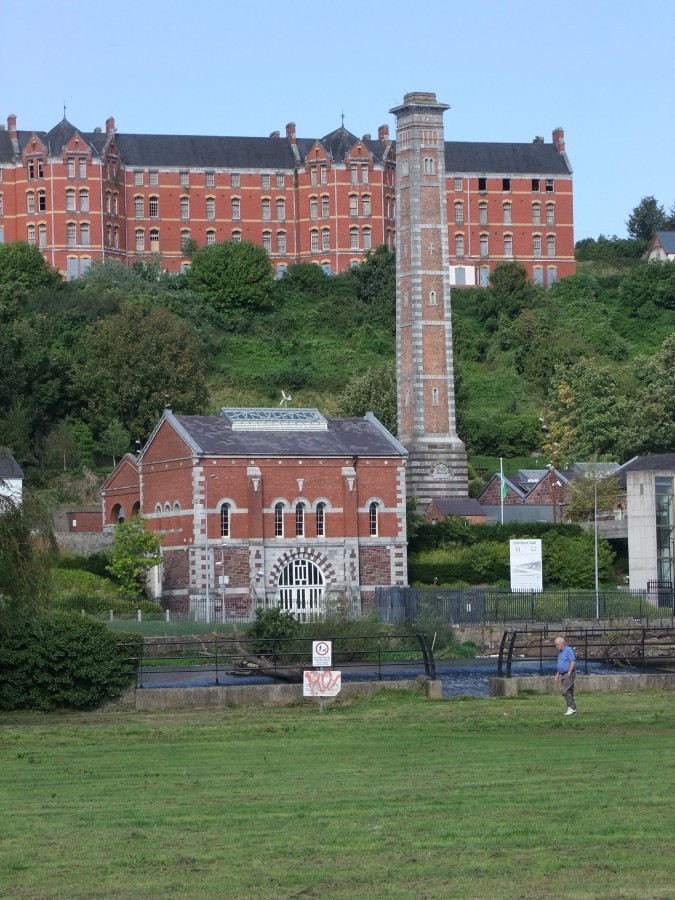
A great Cork Heritage Open Day 2018; well done to the organisers, building owners and volunteers! some pictures below I took on the day 🙂
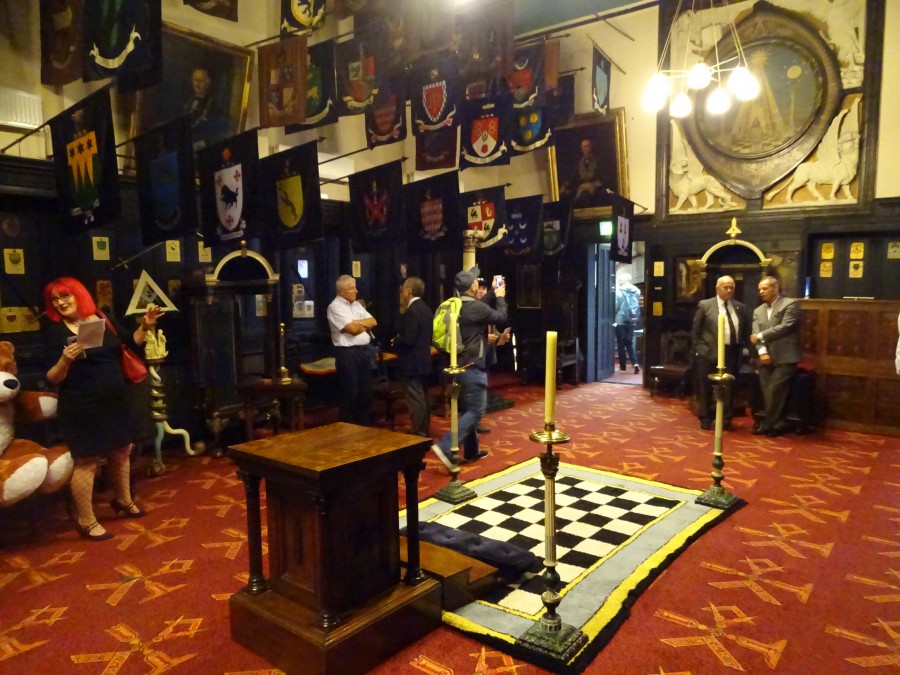
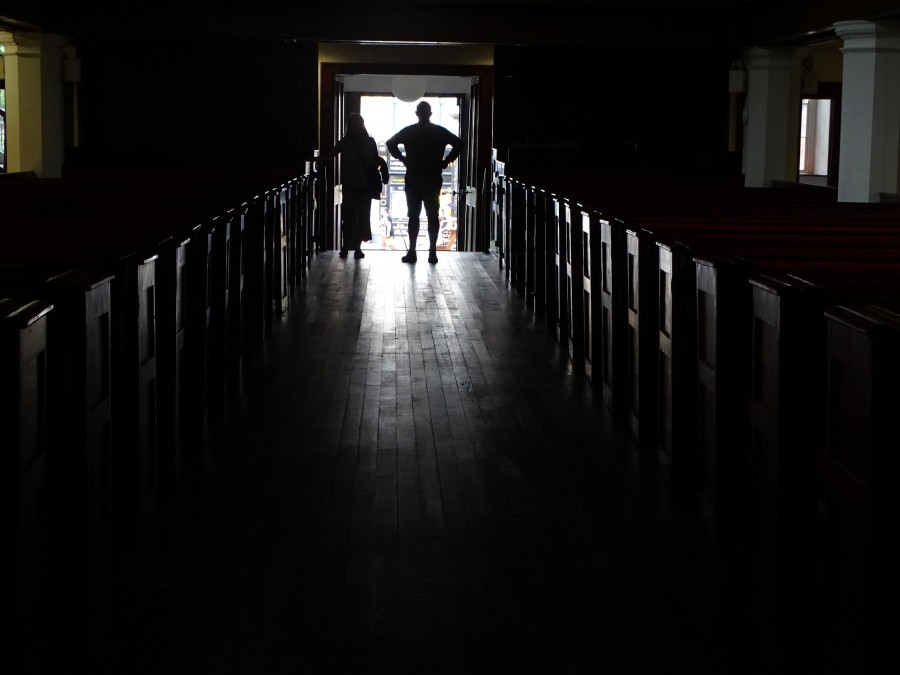
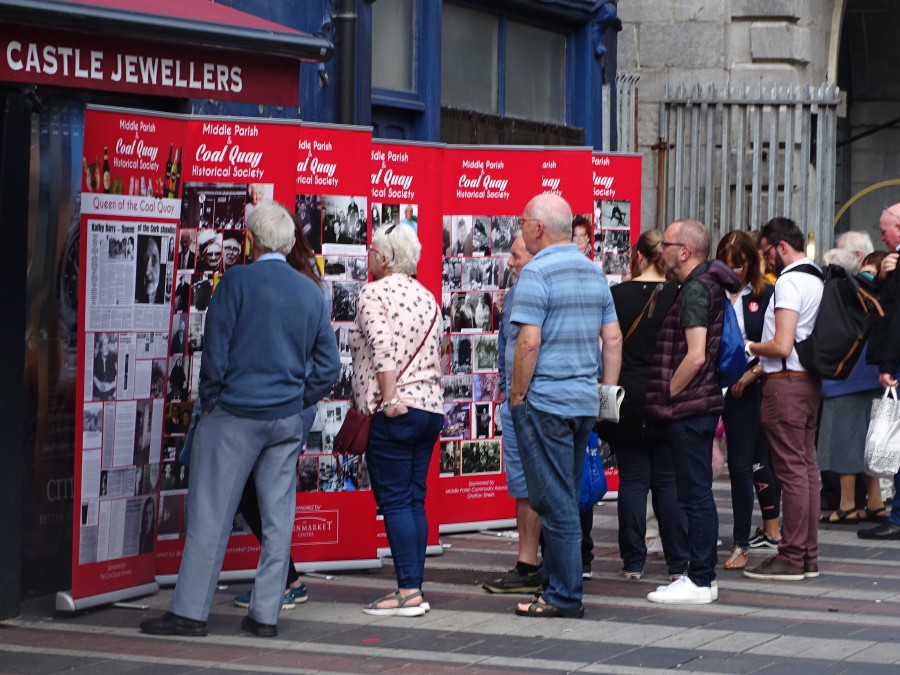
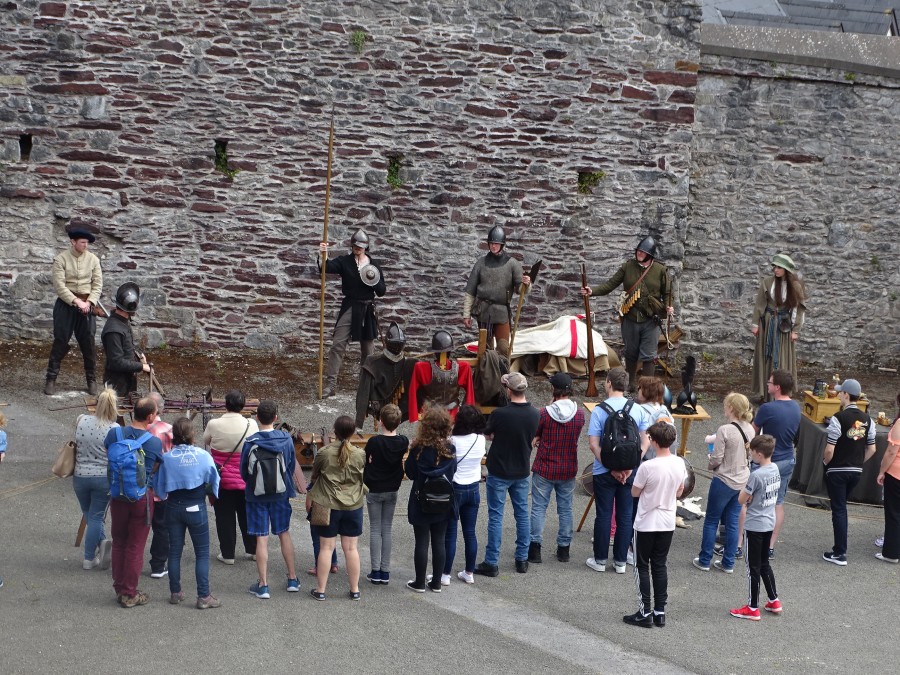
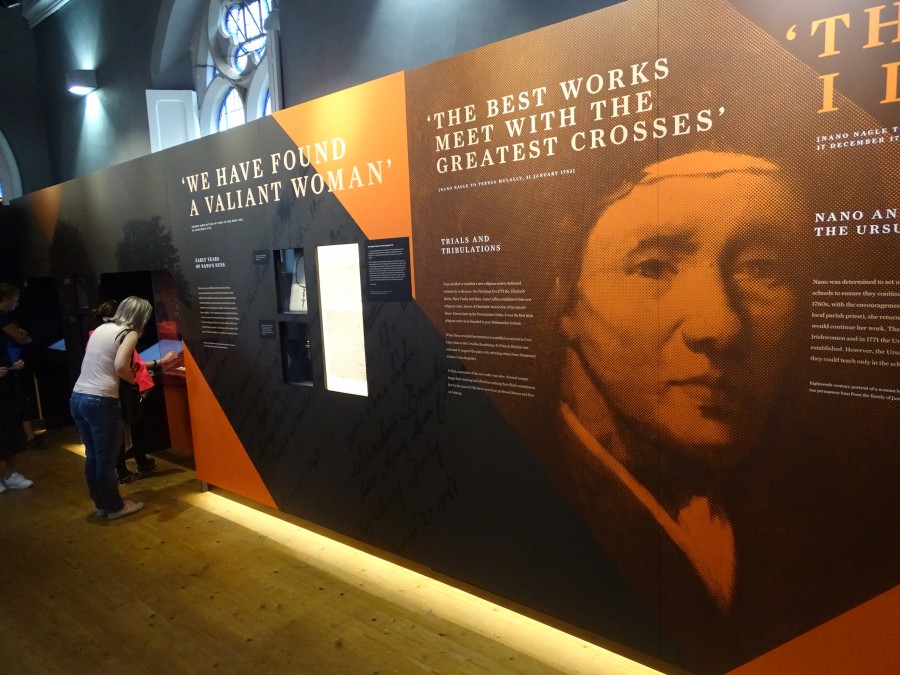
Press Release
Independent Cllr Kieran McCarthy has called for more marketing mechanisms to be added to the recent suite of parking initiatives introduced to the City Centre.
Cllr McCarthy noted: “Marketing the city Centre is crucial to keep it vibrant and attractive. An ongoing ‘Support Town’ campaign is essential. The City Council and traders need to develop mechanisms to face off against the challenges of online buying”.
Cllr McCarthy highlights that the city has many traits which are different to those of a shopping centre. “The City Centre has a stronger sense of place – we need to keep capturing this sense of place and continue to make it meaningful and personable to citizens. Trade and business in the city is diverse. Sometimes I feel the sense of diverseness is perhaps not celebrated enough”.
“We need to continue the online advertising of the city –our attractions, arts and culture, and festivals need to be consistently captured- I often feel we don’t plug our festivals enough. The surprise, fun, & experience within the city need to be at the forefront of the City Centre’s future”.
“We need to push more that the city is a great space for entertainment, socialising, and learning. It is a space where people can come together and enjoy themselves.
In general the quality of the experience of the city is clean, safe, and welcoming.
The education and Lifelong Learning element of the city need to become stronger tenets of City Living. We can be justly proud of the annual Lifelong Learning Festival”.
The Healthy City element needs to be opened up more. The city has many age friendly city projects as well as food policy council initiatives, which we need to hear more about.
Collaboration and coalitions work well when they are applied to the city and different groups work together with the Council. We have witnessed that with the Re-Imagine Cork and Mad About Cork initiatives. The more facilitation of ideas from community networks the better in informing different ways of engaging the City Centre and its future.
Ultimately the City Centre needs to build customers– rewarding and building loyalty.
We need to mind our shops, many of which have a deep family history, the SMEs, our Independent shops. The city
needs to hear more about SME development and start-ups; we need to hear more about the projects of the Local Enterprise Office. The City Centre certainly needs a strong Digital City Retail Strategy, which is absent at the moment. These are just some of the many strands, which need to be brought together to think holistically and act upon the future of the City Centre”.
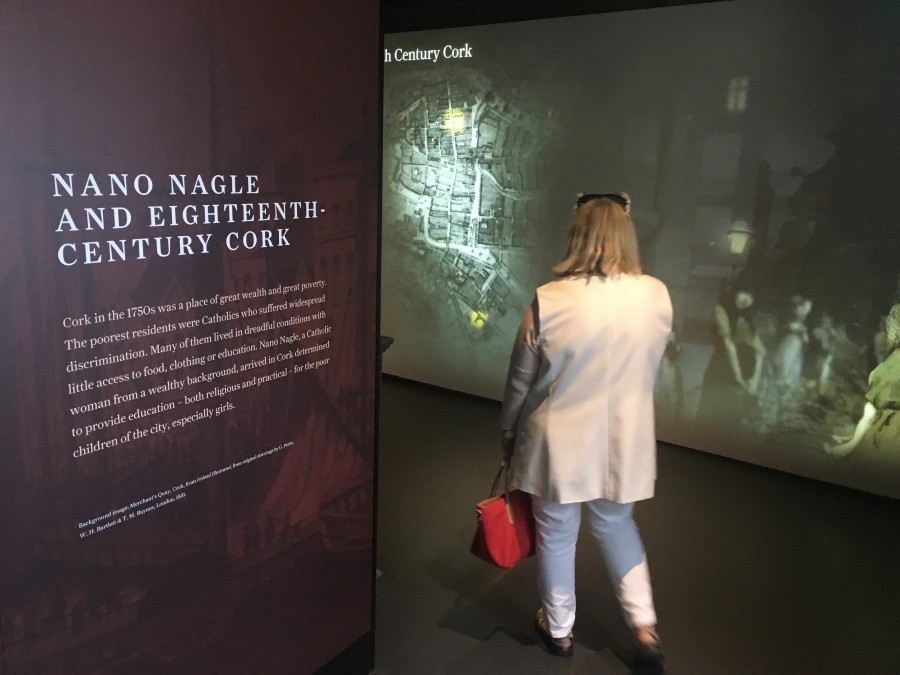
Kieran’s Our City, Our Town Article,
Cork Independent, 16 August 2018
Cork Heritage Open Day, 18 August 2018
Cork Heritage Open Day takes place this Saturday 18 August with over 40 buildings and nearly 100 associated events happening. As a way of referencing the buildings’ locations, five themed self-walking routes throughout the city are suggested on the map on the guide you can pick up at venues or online at www.corkheritageopenday.ie. But one can make up your own route as well. It took me a few years to get to all of the buildings and even now returning to many of them, the non-rush makes for a more savoured approach. You can revel more in the detail of buildings and their historical context and nuances through displayed old documents, objects and pictures. Some buildings cross many timelines in their development and there is no better guide than to chat to building owners.
The team behind the Open Day at Cork City Council group the buildings into general themes, Steps and Steeples, Customs and Commerce, Medieval to Modern, and Life and Learning and Saints and Scholars – one can walk the five trails to discover a number of buildings within these general themes.
On the Saints and Scholar’s route is the Nano Nagle Place. Like many other heritage buildings in Cork City, it an unexpected oasis in the centre of bustling Cork City. It is a place that celebrates Nano Nagle’s vision of empowerment through education, community inclusion and spiritual engagement for a contemporary world. The complex houses a heritage centre, gardens, a café, and shop. The beautifully regenerated convent buildings are home to several educational charities.
The heritage centre opens with a late eighteenth century John Rocque map of Cork City, which is one of my favourite maps to study. The era is interesting to study from a city, trade and population expansion to the social challenges problems within Cork. Nano Nagle was born in Ballygriffin townland, twenty miles north of the city in the parish of Killavullen in 1718. She was the eldest of seven children of wealthy, well-connected parents. At ten years of age, she left country to go to school in Paris with her sister Anne. This was the custom at the time of all well-to-do families Catholic families.
Nano remained in Paris after her schooling but was brought back to Ireland when her father died. She subsequently went to live with her widowed mother in Dublin. However, a double tragedy struck soon after when her mother died in 1748 and Anne died a year later. Grief-stricken, she returned to Paris where she entered a convent.
After several years of training in Paris, Nano heeded the advice of a Jesuit priest to return again to Ireland. Her aim was to help the crucial plight of the poor children in the country of the time. Returning in 1754, she lived with her brother Joseph and his wife Frances. In Cork, Nano Nagle provided her own wealth in helping poor Catholic children in the city. Among the backdrop of influential charity schools in the city for Protestants, she particularly wanted to provide education and instruction in the Roman Catholic faith.
Nano’s first school was in a little rented cabin on Cove Street, now Douglas Street. This school was established in a time when the Penal laws against Catholic worship were not fully in force. Public teaching of the Catholic religion did carry a large fine plus jail for three months jail for each offence. She also ran the risk that the political climate could change, and the penal laws could be tightened up.
Such was Nano Nagle’s presence in the city that she established her own congregation of sisters in 1776. This was her way of establishing a more permanent basis for her schools. Her foundation was named “Sisters of the Charitable Instruction of the Sacred Heart of Jesus” (which became the Presentation order in time). Nano died on 26 April 1784 aged 65 years.
As Nano Nagle was consolidating her first school in the 1760s, the topography of the city was gearing up for further changes. In 1761, new by-laws were passed which aimed at collecting more taxes from citizens to enable improvements in public ‘wick in oil’ lighting in the city, in creating a new water pipe supply and building two new bridges. The first bridge was to span from Princes Street to Lavitt’s Island (later Morrison’s Island). The second was from Lavitt’s Island to Red Abbey Marsh. This is now the site of present day Georges Quay. In otherwords the second bridge proposed was the forerunner of present day Parliament Bridge (built 1806).
In 1763, the first bridge occupied by St Patrick’s Bridge was proposed. At the time, North Gate Bridge still was the only crossing point over the north channel into the city. An increase in the number of inhabitants using Mallow Lane (now Shandon Street) to gain access to North Gate bridge was prevalent. Carriages and foot passengers are described as too many making movement for pedestrians dangerous on Mallow Lane. In addition, the growing butter trade in the city in the area of present day Shandon meant that a large number of merchants were living in Blackpool, who required better access to the city centre and docks areas.
Kieran’s Cancelled Tours:
Unfortunately, due to surgery on a herniated disc, I am unable to conduct tours for National Heritage Week next week. My tours, which appear on Cork City Council’s brochure are all cancelled. However, there are many other talks and walks, which appear on the brochures, and this information can be picked up from Cork City Hall, the libraries or viewed online.
Captions:
959a. Entrance to Nano Nagle Place Heritage Centre, present day (picture: Kieran McCarthy)
959b. Restored convent building, Nano Nagle Place, present day (picture: Kieran McCarthy)
959c. Presentation Sister graveyard, Nano Nagle Place, present day (picture: Kieran McCarthy)
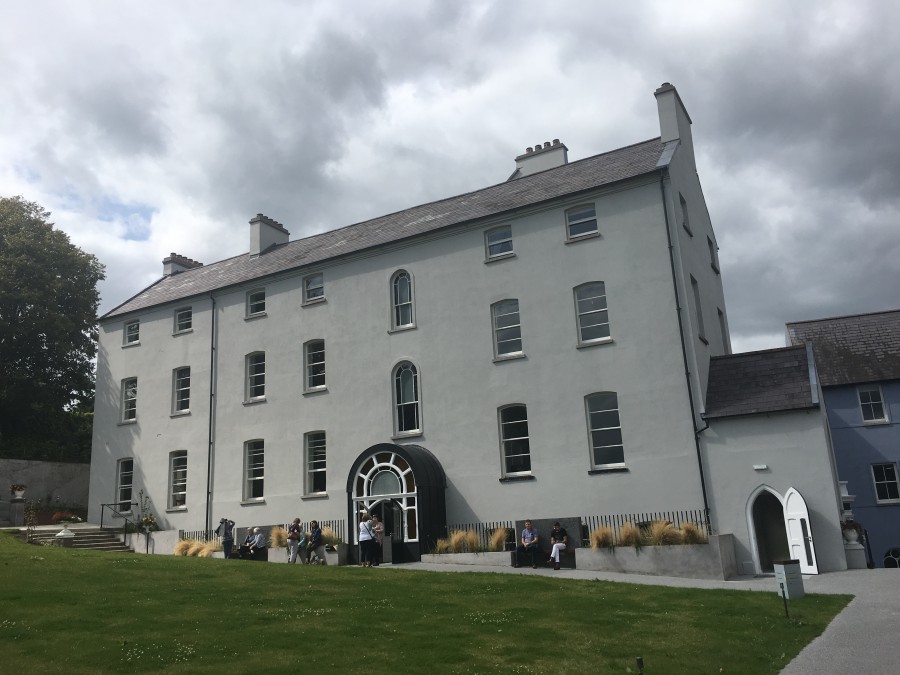
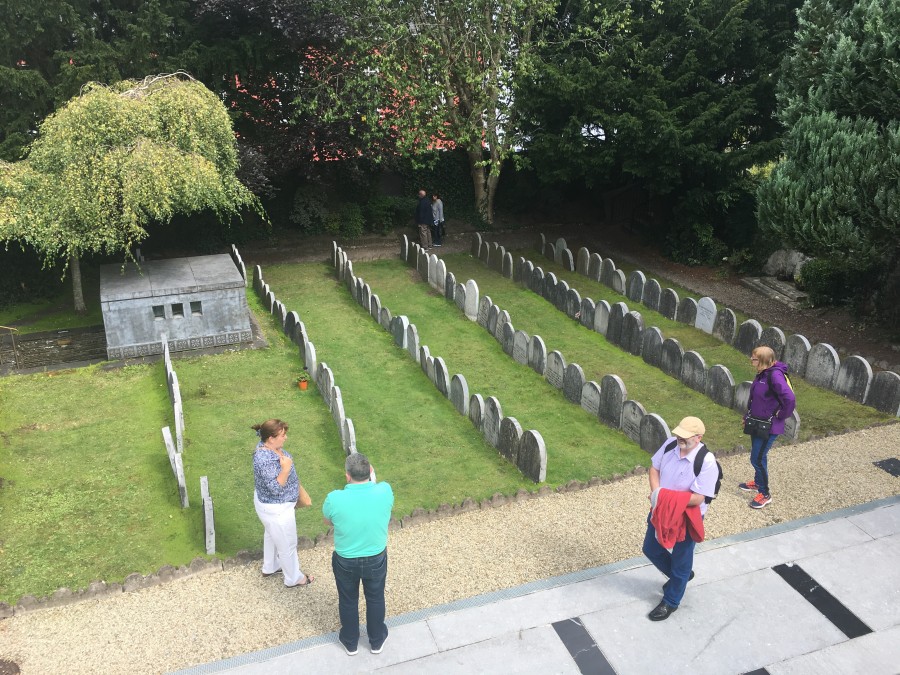
Independent Cllr Kieran McCarthy’s heritage week walking tours, which included one on the history of Douglas Village have been unfortunately cancelled next week. Cllr McCarthy recently had emergency surgery on two herniated discs in his lower back and is currently recovering; “I am really gutted to be missing Cork Heritage Open Day and Heritage Week this year. It’s my first year since the creation of National Heritage Week where I won’t be able to run my tours in different parts of Cork City. I encourage Corkonians and visitors to explore other activities listed on Home | National Heritage Week 18 – 26 August 2018.
Cllr McCarthy in particular noted that the organisation of Cork Heritage Open Day on this Saturday 18 August is “akin to Christmas Day for art, architecture and built heritage lovers”. The Open Day celebrates its 15th anniversary this year. Last year it was estimated that there were over 18,000 visits to the 42 buildings and events on the day. The Open Day is organised by Cork City Council as part of National Heritage Week and the team works closely with building owners, local historians and communities who give their time free of charge. The success of the event lies with the people behind the buildings who open their doors willingly every year to allow the public a glimpse of the amazing and unique built heritage of Cork City.
“It is always a great opportunity to explore behind some of Cork’s grandest buildings. With the past of a port city, Cork architecture is varied and much is hidden amongst the city’s narrow streets and laneways. Much of its architecture is also inspired by international styles – the British style of artwork pervading in most cases– but it’s always pays to look up in Cork and marvel at the Amsterdamesque-style of our eighteenth-century structures on streets such as Oliver Plunkett Street or at the gorgeous tall spires of the city’s nineteenth-century churches.
Cllr McCarthy continued: “With 42 buildings open to the public for Cork Heritage Open Day it is almost impossible to visit them all in one day. It takes a few goes to get to them all and spend time appreciating their physical presence in our city but also the often-hidden context of why such buildings and their communities came together and their contribution to the modern day urban landscape of the city. The team behind the Open Day do group the buildings into general themes, Steps and Steeples, Customs and Commerce, Medieval to Modern, Saints and Scholars and Life and Learning – one can walk the five trails to discover a number of buildings within these general themes. These themes remind the participant to remember how our city spread from the marsh to the undulating hills surrounding it – how layered the city’s past is”.
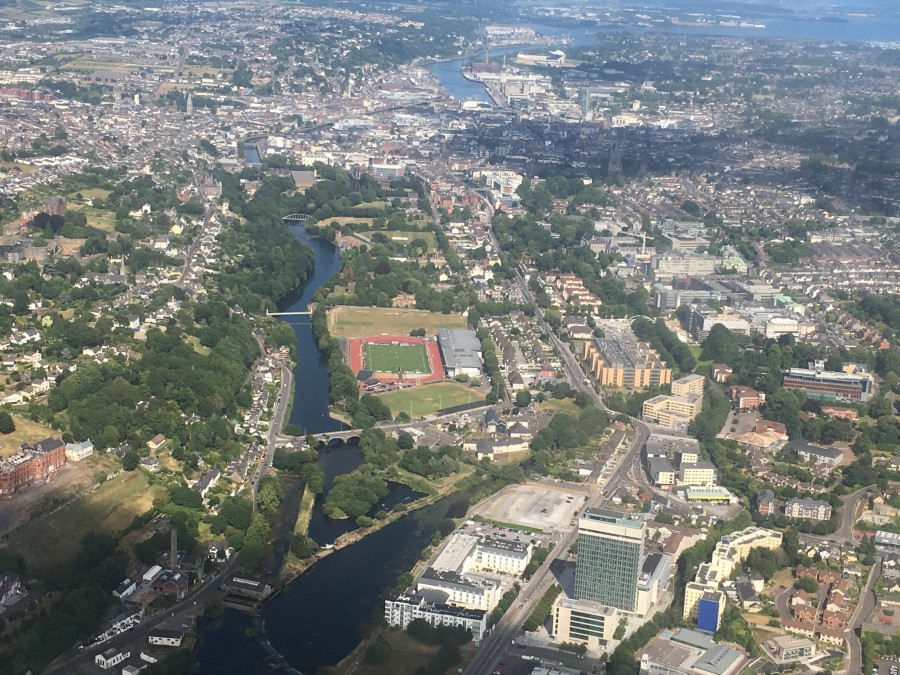
Cllr Kieran McCarthy Press Release:
“I am very disappointed to see this; the city council really needs a better tree management plan. I have asked several times since Storm Ophelia that finance be put aside to replant trees on the Marina and in the wider city. During Storm Ophelia 500 trees came down and 500 trees were damaged. I asked at the time that in light of the damage and the Council’s lack of funding reserves for tree replanting, that the Minister for Local Government and Environment be written to and pressure be put on him to source appropriate funding. Funding was not forthcoming. I continue to raise the matter at Council level. I have a question on hold to the Chief Executive to be answered in early September on works on Centre Park Road and the future of the tree line there.
I remain a strong advocate that the city needs a much stronger urban greening agenda. It does not cost much or take much to plant a tree. I appreciate the cost of maintaining trees in an urban area and that the Council have lost much manpower on its tree planting and pruning crews, but trees are the DNA of Cork City’s landscape and what makes it special. I appreciate the health and safety concerns of filling in the roots of fallen trees on the Marina, but as soon as funding is made available I will strongly asking for the concrete to go and new trees replanted on the Marina”.
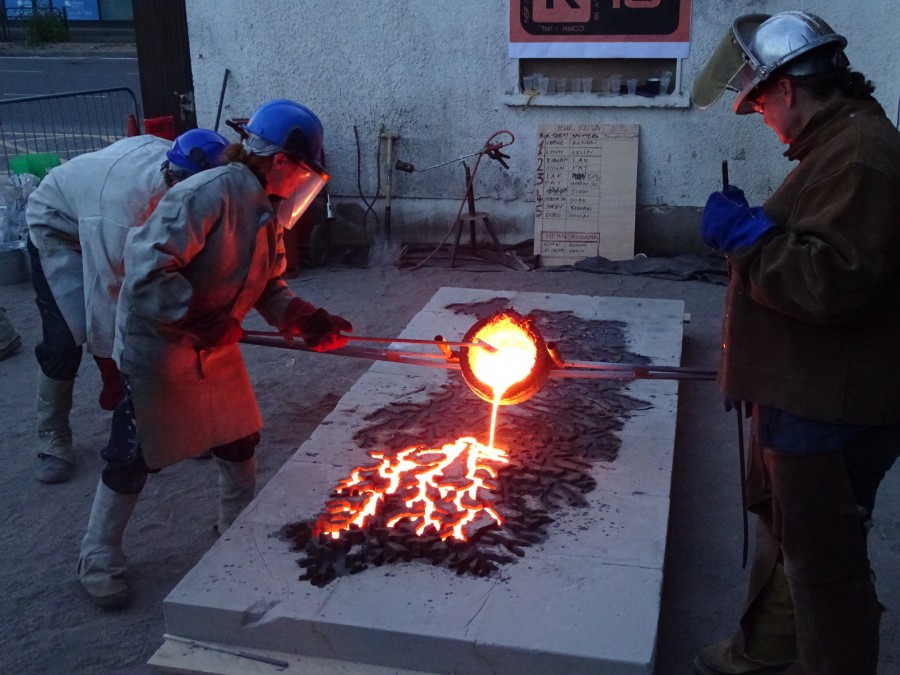
Kieran’s Our City, Our Town Article,
Cork Independent, 9 August 2018
Cork Heritage Open Day, 18 August 2018
Cork Heritage Open Day celebrates its 15th anniversary this year. This year it takes place on Saturday 18 August with 42 buildings and nearly 100 events and festivals happening. Last year it was estimated that there were over 18,000 visits to the buildings and events on the day. The event is organised by Cork City Council as part of National Heritage Week and the team works closely with building owners, local historians and communities who give their time free of charge. The success of the event lies with the people behind the buildings who open their doors willingly every year to allow the public a glimpse of the amazing and unique built heritage of Cork City.
It is always a great opportunity to explore behind some of Cork’s grandest buildings. With the past of a port city, Cork architecture is varied and much is hidden amongst the city’s narrow streets and laneways. Much of its architecture is also inspired by international styles – the British style of artwork pervading in most cases– but it’s always pays to look up in Cork and marvel at the Amsterdamesque-style of our eighteenth-century structures on streets such as Oliver Plunkett Street or at the gorgeous tall spires of the city’s nineteenth-century churches.
With 42 buildings open to the public for Cork Heritage Open Day it is almost impossible to visit them all in one day. It takes a few goes to get to them all and spend time appreciating their physical presence in our city but also the often-hidden context of why such buildings and their communities came together and their contribution to the modern day urban landscape of the city. The team behind the Open Day do group the buildings into general themes, Steps and Steeples, Customs and Commerce, Medieval to Modern, Saints and Scholars and Life and Learning – one can walk the five trails to discover a number of buildings within these general themes. These themes remind the participant to remember how our city spread from the marsh to the undulating hills surrounding it – how layered the city’s past is, how the city has been blessed to have many scholars contributing to its development and ambition in a variety of ways and how the way of life in Cork is intertwined with a strong sense of place.
The trail Steps and Steeples is a very apt way to describe the topography of our city. The trail encompasses not only some of the amazing buildings on the northern hills of the city, but also some of the most spectacular views. Admire the interior of Everyman Palace on McCurtain Street, re-examine the crooked but limestone inspiring spire of Cork Trinity Presbyterian Church, gorge on the stained glass windows of St Luke’s Church, re-imagine past hospital treatment at the Ambassador Hotel, revel in how many barrels of beer have been exported from the former Murphy’s Brewery, now Heineken Ireland, reminisce of Cork’s North Infirmary at the Maldron Hotel, attempt to count how many barrels of butter were weighed at the Firkin Crane, ring the bells of St Anne’s Church, Shandon.
At Collins Barracks read up about the military history underlining the city’s and harbour’s development. The military museum at the Barracks has three themes – the history of the Barracks, Michael Collins and Peacekeeping. The core collection consists of memorabilia associated with Michael Collins and also has displays from donated private collections. The Heritage Day brochure remarks that the Barracks building is a fine example of Georgian Architecture. It is also significant from a historic perspective. The fine limestone gateway has been the focal point of historic events in Ireland since the time of the Crimean War in 1856 with the return of the seventeen Lancers after the Battle of Balaclava. It was the location for the handing over of the Barracks from the British Government to Commandant Sean Murray of the Irish Army in 1922, and was visited by President Kennedy in 1963.
Meanwhile down by the river, the Customs and Commerce walk follows the Lee and showcases some of the old and new commercial buildings in the city. These buildings track the commercial history of Cork City and highlight its many industries over time. For the more energetic walker this route can be combined with the Medieval to Modern walking route. Think highly of the multiple stories of the city’s masons and carpenters at the Carpenter’s Hall; feel the energy of the steam ships in the maritime paintings in the city’s Custom House, and look at the fine details on the pillars within AIB Bank on the South Mall. Learn about local government in the City Hall. Re-imagine the turning of the wheels of the trams at the National Sculpture Factory.
The National Sculpture Factory, set up in 1989 is a thriving artists resource facility, where artists are working on many creative projects. It is a significant national resource and is primarily funded by the Arts Council and Cork City Council. One hundred years ago, the National Sculpture Factory was once the central hub for electric trams whose trackways created arteries through a bustling city of contrasts from slums to richly embellished Victorian terraces in the city’s middle-class suburbs. The site was also the electricity distribution centre, which changed the way of life for citizens. The trams supplied a rhythm through the city – their stopping, going and wining- the iron wheels pushing into the tracks moving through the city, connecting citizens.
More at www.corkheritageopenday.ie
Captions:
958a. Pouring iron ore recently onto Tamzie Ringler’s River Lee’s mould at the National Sculpture Factory, July 2018 (picture: Kieran McCarthy)
958b. Christ Church during sunset in February 2018; one of the 42 buildings to be celebrated for Cork Heritage Open Day 2018 (picture: Kieran McCarthy)
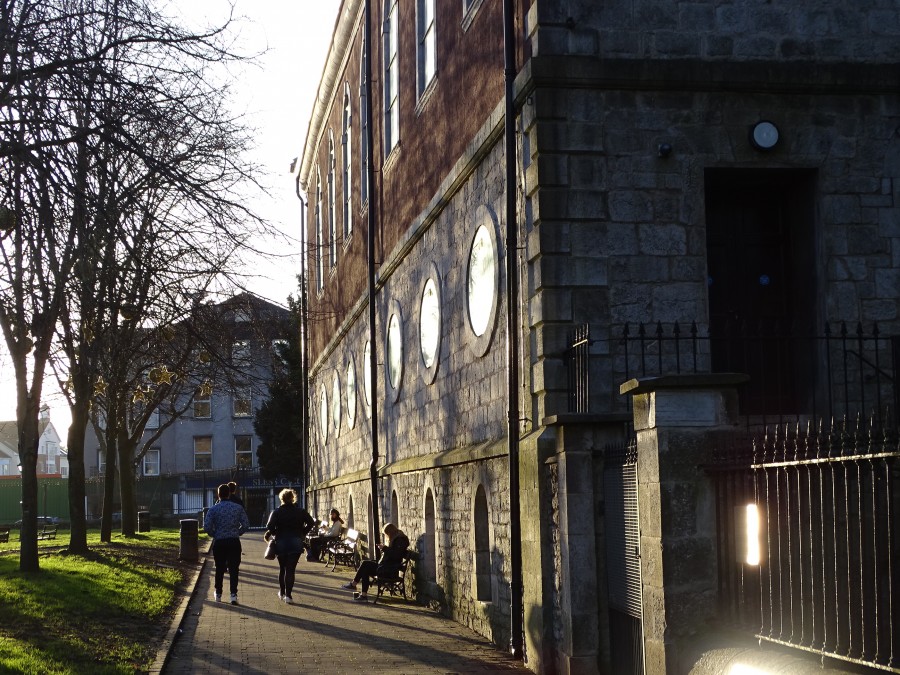
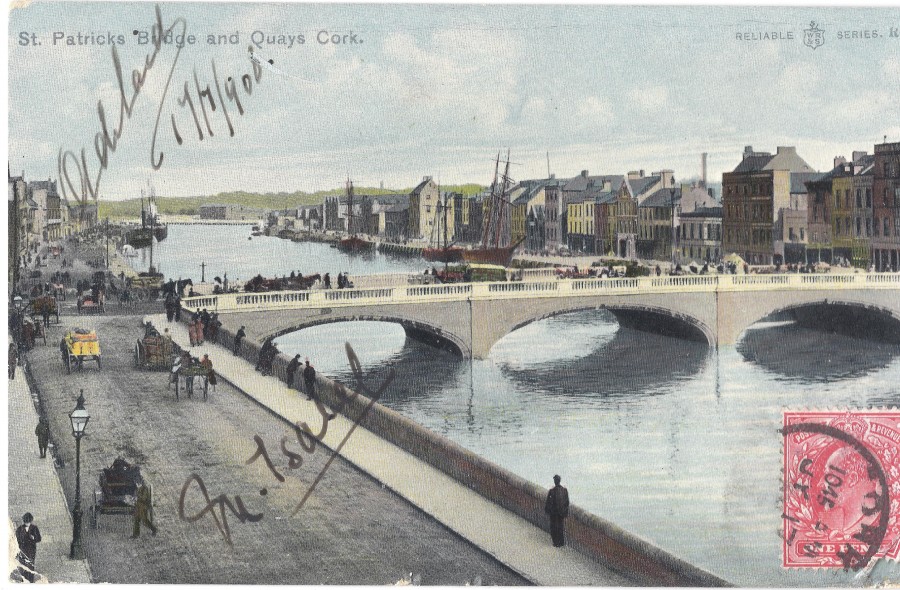
Kieran’s Our City, Our Town Article,
Cork Independent, 2 August 2018
Stories from 1918: The Strikes of the Dockers
This week one hundred years ago on Saturday 27 July 1918 circa 250 members of the Cork Branch of the National Union of Dock Labourer struck work following the failure of negotiations in relation to calls of increased wages and fixed working hours. Workers had been engaged in the different levels of work connected with the unloading and loading of steamers. About 30 men handlers of the green timber traffic, and members of the same Union, were also affected at first. However, a satisfactory settlement of wage and time terms was brought about, and the men resumed work. The settlement was £3 per week and a nine-hour day.
The Shipping Companies issued a public statement, which was published in the Cork Examiner. It referenced a letter received from the Union in January 1918 looking for a demand for an increase in wages. The companies replied that it was not possible for them to entertain an application for any increase but a request was made to the government to sanction certain increases in pay rates. In May 1918 the government had sanctioned certain increases in workers’ pay. The information was relayed by the Cork shipping companies to the men’s Union Headquarters in Liverpool that they would be prepared to discuss with their representative, if he was sent over. They were unable as the Union was in talks with the Ministry of Labour on other but similar files elsewhere in England.
The Union Representatives in England argued that a uniform rate at all Irish ports was crucial. However, the Ministry argued that the volume of traffic and regularity of work varied so widely and wished for separate consideration for each port. The weekly dockers in Waterford were paid slightly higher but got no overtime unless they worked on Saturday night or Sunday, while the daily labourers and carmen were paid higher in Cork, and all classes of workmen received overtime on every day that was worked.
In a letter by John Sutton, Secretary of the Cork Branch of National Union of Dock Labourers, and published in the Cork Examiner on 29 July, it highlighted that the demand was £2 5d 0d per week. The men gave the obligatory notice of eight days. Mr Sutton relayed that the lowest paid docker in Waterford and Derry received £2 7s 6d and £2 10s respectively and a nine-hour day. Men in Cork received from £1 17s 6d to £2 4s 6d with a bonus included but with a ten-hour day.
A book by John W Boyle entitled The Irish Labour Movement in the Nineteenth Century (1988) delves into the archives of the National Union of Docker Labourers (which survive in Kew Archives in London). The National Union of Dock Labourers was established in Glasgow in February 1889. It was part of the mass mobilisation of semi-skilled workers and labourers into general large unions. The Gas Workers and General Labourers’ Union and the National Amalgamated Union of Labour also emerged in the UK. In 1894 the Irish Trade Union Congress was set up by the two trade councils of Belfast and Dublin.
By May 1889, the National Union of Dock Labourers (NUDL) had a branch in Belfast. In a short time, the branch had four hundred members out of the two thousand men eligible in the Port of Belfast. By the middle of 1891, the NUDL had branches in fifteen Irish ports and paid up membership dues of circa 2,000 men. Enrolment continued apace when employer counteroffensives were successful. Wages in Irish Ports, which had been as low as ten shillings per week, with men working from 6am to 9pm for two shillings, had increased substantially by amounts ranging up to 30 percent.
The Irish Home Rule Campaign caused a rift between Protestant Belfast members and Catholic south of Ireland members. In 1895, there remained four branches – Dublin, Derry, Drogheda and Cork. The Dublin branch ceased operation in 1900. Amidst these years, the Union organiser James Larkin pushed for re-establishment of branches in 1907 and 1908. However, the finding of Larkin’s use of funds from re-organised branches such as Cork in an effort to fight ongoing employer offensive campaigns led to his jailing for a year. His subsequent release led him to establish the Irish Transport and General Workers’ Union (ITGWU).
As for the NUDL, it transferred its headquarters to Liverpool and within a few short years was most closely associated with Merseyside. The union retained a strong presence in a number of Scottish ports but closed its Glasgow branch in 1910 and was replaced locally by the Scottish Union of Dock Labourers, which was formed during the seamen’s and docker’s of 1911. The Union represented 55,000 members.
The offices of the Cork Branch of National Union of Dock Labourers were located at 4 Merchant’s Quay. Apart from the 1918 summer strike and another one a year earlier in the summer of 1917, very little historical information has survived of the Cork Branch and its activities in the 1910s, which at this time would have been affiliated the ITGWU. In addition, large-scale publications on trade unionism in early twentieth century Cork remain to be published. In late 1910s Cork, the Cork branch of the NUDL with its 250 members were a formidable force on the docks of Cork City, that plus the presence of the smaller Stevedore union groupings.
Captions:
957a. Postcard view from Camden Quay of St Patrick’s Bridge and Merchants’ Quay, 1908 (source: Cork City Museum)
957b. Postcard view from Merchants’ Quay of St Patrick’s Quay, c.1900 (source: Cork City Museum)
